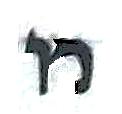Therefore, the
basic pieces of a letter [for ex. a hai has 3 pieces, gag & 2 feet] their
minimum measure that is accepted, is the minimal letter of yud.
This keeps the
basic structure of all the letters/script in a unified size.
We find the use
of the yud also a measure for the separation of words from each other, that
l'chatchila they should be seperated the size of a ois ketana which is the yud
(MB 32:143). And even for bdieved this measure is used, for measuring the separation
of one parsha from another parsha = 9 oisios, the minimal ois being a yud. So
the shiur [of revach parsha] is 9 yudim.
The chidush is, that
we see Chazal used the shiyur yud also to the width, not only to the length as
in the foot of hai.
The basic unit of
measure for script in stam, is a yud.
Now one can assume
that if Chazal established a shiur for the foot of an ois, definitly there must
be a shiur for all basic parts of the ois!
This is what the
MB is teaching us: the moshav of the lamed has the shiyur MOK, and so should
be the minimum measure for any moshav of a letter (unless there is a special
instruction teaching different – as the BH writes in regard to the kuf).
From this I would
assume that this min. measure of OK should apply to other moshavim also, example
- mem psucha has a moshav. If the moshav of its caf isn't MOK, the mem isn't
kosher [unless fixed]. I am thinking about some other the letters (for exa.
tes, samech,..)
Although the right
side of kuf and lamed where not included in MOK as explained [the post before],
nevertheless it doesn’t make sense that they are less important than the foot
of hai & its group, therefore a very short kuf or lamed may be pasul,
because its lacking the shiyur of its right side!
Another example
is the heads of thin letters like vav, zayin, the zayinim of the ches, the
heads of shaatnez getz, the yudim of alef and pei, are all distinct pieces and
must have a shiyur minimum = MOK.
It would seem
less than a yud in any of these situations isn't MOK and pasul.
Another point in
regard to shiyur MOK of moshav ha'lamed.
How is this
measured? By the length of the yud from
top to bottom which is obvious 1k (and according to MB 32:44 a yud with a regel
– 1.3k) or the width of the yud, and a regular yud in a particular csav may be 0.7k.
I would think
that in regard to the moshav (and any piece that is measured
right to left) the measure should be of the width of a regular yud in this particular csav. Just as the
measure of 9 oisios ketanos for a separation between parshiyos is 9 small letters,
which are the width of 9 yudim of this csav.
But whenever the
measure is to the highth of the piece like the yerech of hai the measure is the
hight of the yud – 1k.
[maybe the yudim
of alef and pai above, may be measured as a yud to their width - as the width of a yud??]
Popular posts from this blog
Klaff Tanning question:
By
Rabbi Eli Gutnick
-
I received this question via email. I am not really a klaf expert, I was wondering if anyone could answer this question: Dear Rabbi Gutnick, I am writing to you because a good friend of mine has put the idea into my head that the klaf in my tefillin were not really tanned and therefore are not kosher. He referred me to Megilla 19a re diftera. From the research that I have done so far, it seems that the klaf that is used today is tanned only with a lime wash. On all of the tanning websites I’ve seen so far, they say that the lime doesn’t accomplish tanning but only the removal of the hair and some other pre-tanning effects. Would you be able to explain to me or refer me to a website that explains how the tanning process that is used today takes the hide out of the category of diftera? Thank you very much.
Rabbi Reuvain Mendlowitz clarifies his position on Ksav Chabad (and my final thoughts)
By
Rabbi Eli Gutnick
-
Last week I posted some thoughts in response to a public lecture given by Rabbi Reuvain Mendlowitz regarding Ksav Chabad (the Alter Rebbe's ksav). I felt he did not represent the issue fairly, and since I had received questions about it from a number of people I felt it made sense to write a general response. After I posted my response on this forum, Rabbi Mendlowitz reached out to me by email and we ended up having a respectful and productive email exchange regarding the relevant issues surrounding Ksav Chabad. His position is a lot clearer to me now, and I think he also took certain things on board that I clarified with him. The purpose of the Stam Forum (at least back in it's heyday before all the whats app groups took over) was to connect sofrim from around the world, to promote achdus and build bridges, as well as to offer support and advice. In that spirit, I felt I should write a follow up post, to clarify some of the issues and misconception...







According to Ksav Chabad the right head(s) of the ט׳ ע׳ צ׳ and shin are supposed to less than a mok, so that you won’t “pass up” writing the zaynin on them. According to this would they also need mok? If all the rashei hashin were mok, the width of the entirety of the os would also be longer than three kulmusim
ReplyDelete